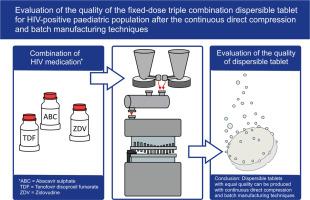Evaluation of the quality of the fixed-dose triple combination dispersible tablet for HIV-positive paediatric population after the continuous direct compression and batch manufacturing techniques
IF 4.7
3区 医学
Q1 PHARMACOLOGY & PHARMACY
引用次数: 0
Abstract
Introduction
Currently, the paediatric population with positively tested human immunodeficiency virus (HIV) is facing challenges in the administration of off-label and manipulated pharmaceutical products due to the lack of dosage forms specifically designed and authorised for paediatric use. This issue raises concerns regarding medication safety, unavailability of appropriate medications, and improper use of existing treatments. Although paediatric patients prefer liquid and powder formulations, the stability of liquid dosage forms and compatibility of powders with many dietary products remain unresolved.
Aim
The aim of this study was to investigate the robustness in the quality and dissolution profiles of fixed-dose dispersible tablets with three different active pharmaceutical ingredients (API) (abacavir sulphate, tenofovir disoproxil fumarate and zidovudine) after utilising continuous direct compression (CDC) and batch manufacturing methods with implemented Design-of-Experiments (DoE).
Methods
The powder and tablet properties were evaluated employing quality standards of the European Pharmacopoeia (Ph. Eur.). CDC and batch process methods were used to produce fixed-dose combinations (FDC) of dispersible tablets with the aid of DoE which involved varying mixing speeds and breaking forces.
Results
The results indicated that CDC and batch methods could offer similar tablet quality attributes in terms of the physical properties of the tablets and dissolution profiles. The dissolution profiles of 15 min indicated that all six DoE points and the batch of tenofovir disoproxil fumarate met the European Pharmacopoeia standard of greater than 80 % of the drug release for immediate-release dosage forms. For abacavir sulphate the tablets from five out of six DoE points and the batch met the acceptable dissolution criteria. For zidovudine, only two DoE points met the acceptable criteria for the dissolution profile which might be related to the physical properties of the API. Moreover, pre-blending could be used to enhance the flowability of APIs and excipients with poor flowability.
Conclusion
FDC dispersible tablets were successfully manufactured with CDC and batch methods. Moreover, the product integrity results were similar for both the production technologies. However, the formulation and pre-blends require further optimization particularly for poorly flowable active pharmaceutical ingredients.

连续直接压缩和批量生产技术后hiv阳性儿童固定剂量三联分散片的质量评价。
导语:目前,人类免疫缺陷病毒(HIV)检测呈阳性的儿科人群由于缺乏专门设计和批准用于儿科使用的剂型,在超说明书和操纵药品的管理方面面临挑战。这一问题引起了人们对药物安全性、适当药物的缺乏以及现有治疗方法的不当使用的关注。虽然儿科患者更喜欢液体和粉末配方,但液体剂型的稳定性和粉末与许多膳食产品的相容性仍未解决。目的:研究三种不同活性成分(硫酸阿巴卡韦、富马酸替诺福韦和齐多夫定)的固定剂量分散片在连续直接压缩(CDC)和批量生产(DoE)的条件下,质量和溶出度的稳稳性。方法:采用欧洲药典(Ph. Eur.)的质量标准对其粉末和片剂性能进行评价。采用CDC法和间歇法制备分散片的固定剂量组合(FDC),采用不同的混合速度和破碎力。结果:CDC法和批量法在片剂的物理性质和溶出度方面具有相似的质量属性。15 min溶出度曲线表明,该批富马酸替诺福韦二氧吡酯和6个DoE点均符合欧洲药典速释剂型释药率大于80%的标准。硫酸阿巴卡韦6个检查点中5个检查点的溶出度均符合可接受标准。对于齐多夫定,只有两个DoE点符合溶出谱的可接受标准,这可能与原料药的物理性质有关。此外,预共混可以提高流动性差的原料药和赋形剂的流动性。结论:采用CDC法和批量法制备了FDC分散片。此外,两种生产技术的产品完整性结果相似。然而,配方和预共混物需要进一步优化,特别是对于流动性差的活性药物成分。
本文章由计算机程序翻译,如有差异,请以英文原文为准。
求助全文
约1分钟内获得全文
求助全文
来源期刊
CiteScore
9.60
自引率
2.20%
发文量
248
审稿时长
50 days
期刊介绍:
The journal publishes research articles, review articles and scientific commentaries on all aspects of the pharmaceutical sciences with emphasis on conceptual novelty and scientific quality. The Editors welcome articles in this multidisciplinary field, with a focus on topics relevant for drug discovery and development.
More specifically, the Journal publishes reports on medicinal chemistry, pharmacology, drug absorption and metabolism, pharmacokinetics and pharmacodynamics, pharmaceutical and biomedical analysis, drug delivery (including gene delivery), drug targeting, pharmaceutical technology, pharmaceutical biotechnology and clinical drug evaluation. The journal will typically not give priority to manuscripts focusing primarily on organic synthesis, natural products, adaptation of analytical approaches, or discussions pertaining to drug policy making.
Scientific commentaries and review articles are generally by invitation only or by consent of the Editors. Proceedings of scientific meetings may be published as special issues or supplements to the Journal.

 求助内容:
求助内容: 应助结果提醒方式:
应助结果提醒方式:


